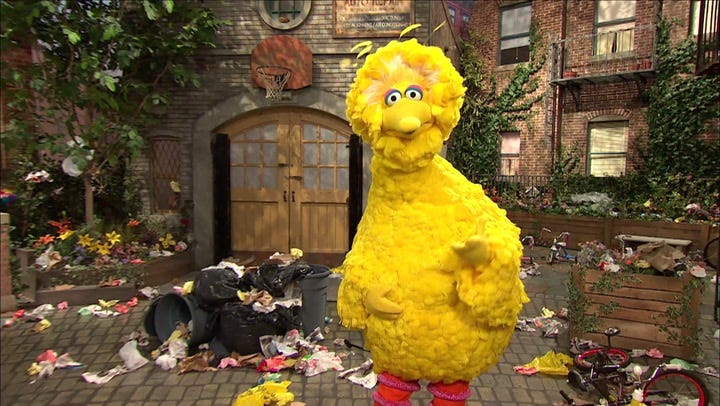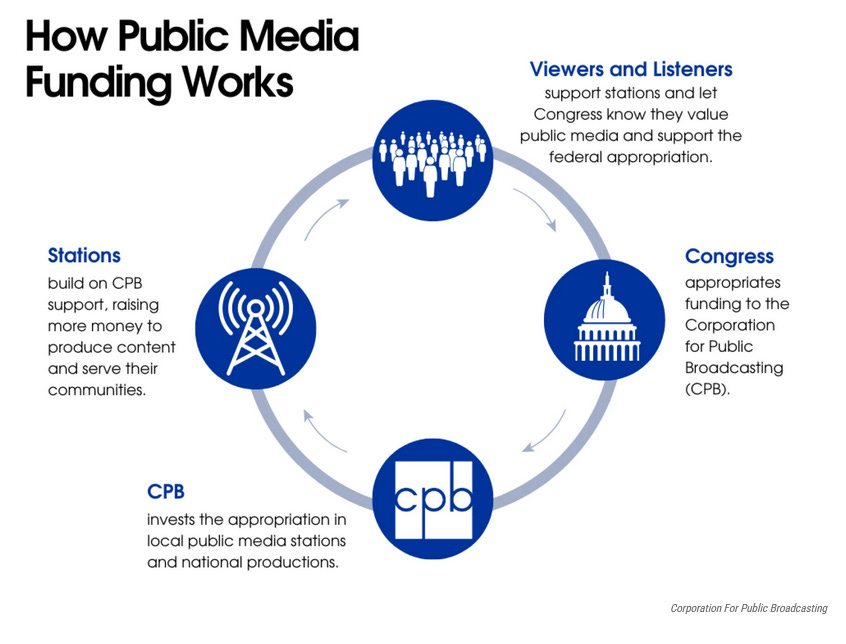Sesame Street Didn't Get Cancelled - But It Did Offer A Glimpse Into The Fate Of Public Media
VILLEGAS | CLMI
Earlier in the year, as anticipated, President Trump announced a slew of cuts to a vast array of federal government agencies, programs and initiatives. So far, based on a pile of rushed executive orders, the administration asserted that it accomplished its planned “50 wins” over 50 days.
Caught up in that fast fury of budget changes - most happening within less than 6 months from the start of this presidency - were accelerated decreases to major public media outfits such as the Public Broadcasting Corporation (known widely as PBS) and National Public Radio (NPR) each heavily relying on federal funding through grants. The key source of those funding streams flows from the Corporation for Public Broadcasting, authorized by Congress in the Public Broadcasting Act of 1967. An estimated 70 percent of its funding is directed towards more than 1,500 public radio and television stations.
Some of that includes Sesame Street, a famed and legendary 55-year-old kids educational institution residing on PBS Kids. Few imagined it could ever leave TV screens. The first episode of the PBS series aired in 1969. From that point on, Sesame Street offered diverse curriculum and characters to kids in over 120 countries. The Sesame Workshop spin-off created resources to “help children everywhere grow smarter, stronger, and kinder.” According to the website, “[with] 1 in 36 children … diagnosed with autism … Sesame Workshop promotes acceptance and provides tools to manage challenges.”
What’s The Correlation Between “50 Wins” And Sesame Street?
Federal grant cuts eventually made their way into the world of Elmo and his friends, despite HBO Max partnering with PBS in 2016 as part of a “relocation” deal to keep it alive. The relationship between Max and PBS grew more complicated since the cable giant offered a home to Sesame Street in 2016 - but, last year, decided not to renew the deal. Even before federal budget cuts in 2025, the future of the popular children’s program was in doubt. Could Sesame Street be saved?
Fast-forward to 2025, and a new president argues both NPR and PBS have engaged in "biased and partisan news coverage" over decades.
The order instructed the board of the Corporation of Public Broadcasting (CPB), which distributes funding to PBS and NPR stations, to "cease direct funding" to the "maximum extent allowed by law". CPB also announced the immediate and full termination of the heavily used Ready to Learn in May, as …
The U.S. Department of Education notified the Corporation for Public Broadcasting (CPB) that its 2020-2025 Ready To Learn grant is terminated, effective immediately. CPB then informed PBS and 44 public media stations in 28 states and the District of Columbia that receive Ready To Learn grants to stop work immediately, pausing the program in rural and urban communities throughout the country.
“Nearly every parent has raised their kids on public broadcasting’s children’s content. For the past 30 years, Ready To Learn-funded PBS KIDS content has produced measurable, real-world impacts on children’s learning,” said Patricia Harrison, President and CEO of CPB. “Ready To Learn has received strong bipartisan support from Congress for the last 30 years because of the programs’ proven educational value in advancing early learning skills for all children. We will work with Congress and the Administration to preserve funding for this essential program.”
These cuts sparked a panic and layoffs to programming in the public media world considering the important role federal government funding plays in sustaining public radio and television networks. It also shed light on how vulnerable public media is in general to sudden shifts and calibrations in budget priorities due to political demands and decisions. It all depends on how the relationship between government, public funding facilitators and policymakers works …
Sesame Street’s home platform, PBS, receives nearly a quarter of its revenue directly from the federal government. Corporation for Public Broadcasting support was set to provide $325 million to PBS, which would then distribute that money to various individual regional stations. Remaining revenues come from station fundraising and dues, yet most money is still being generated from government funding.
State government funding varies by the state, all according to level of commitment and the capacities of budgets …
What’s The Lesson?
Ultimately, Sesame Street didn’t die. The giant streaming service Netflix picked it up, viewing it as an important piece in their programming pie, where 15 percent of shows are designed for young people. “We are excited to announce that new Sesame Street episodes are coming to Netflix worldwide and PBS Kids in the U.S.,” Sesame Place said in a statement. “The support of Netflix, PBS and the Corporation for Public Broadcasting serve as a unique public-private partnership to enable Sesame Street to continue to help children everywhere grow smarter, stronger, and kinder.” Plus, in a related development …
Yet, despite that public-private partnership and public support, look at how bumpy the road was to getting there, along with the impact of policy decisions. Meanwhile, the media world rapidly evolves and is always uncertain given the rise of streaming, social media and a bottomless program diet. The fate of public broadcasting offers a lesson into how even popular programs such as Sesame Street can realistically survive a volatile terrain of politics and media.
DIAMOND VILLEGAS is a Fellow at the Civic Literacy and Media Influence Institute at Learn4Life
powered by the Civic Literacy & Media Influence Institute at …








